
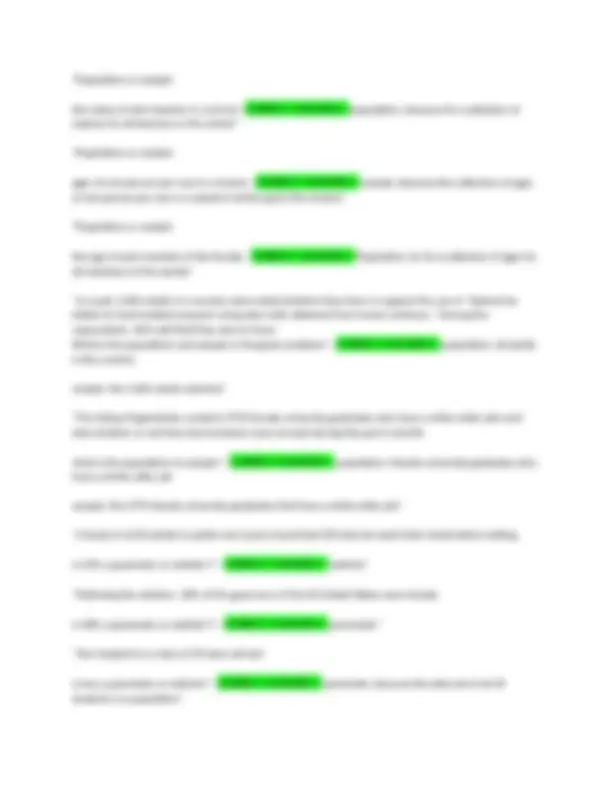
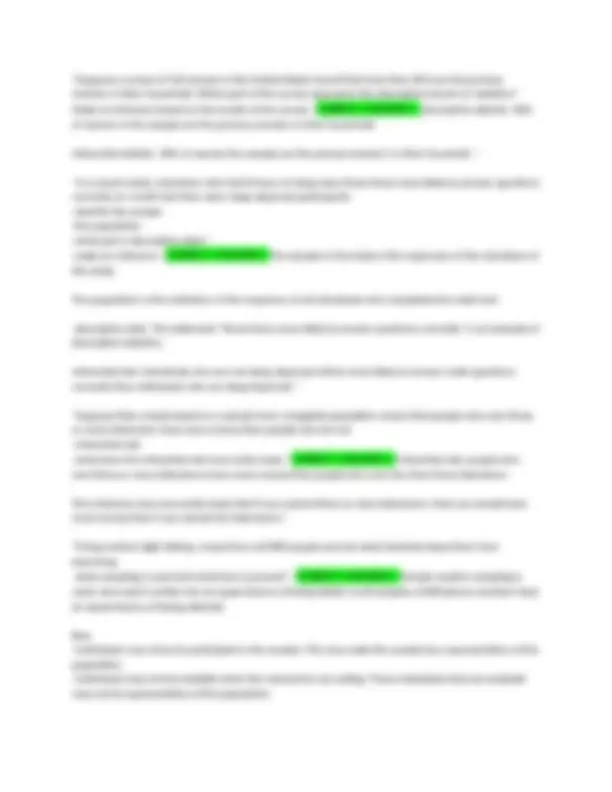
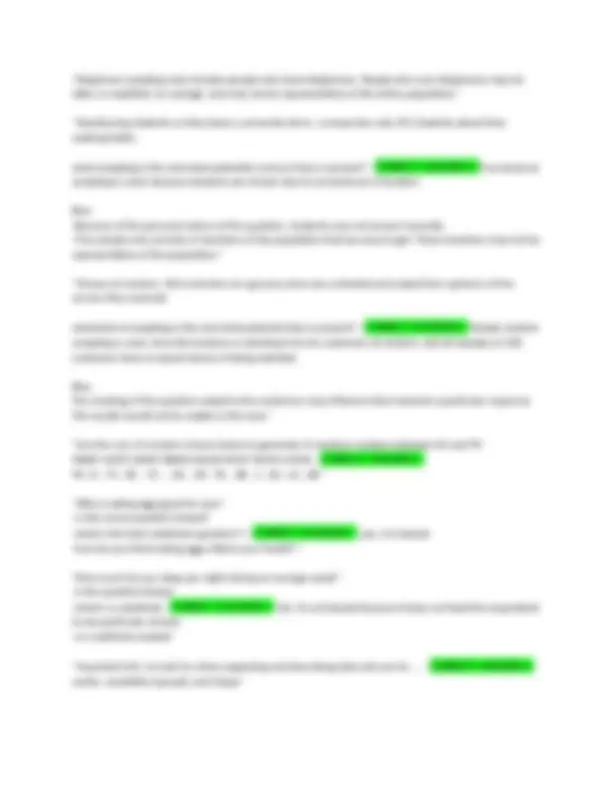
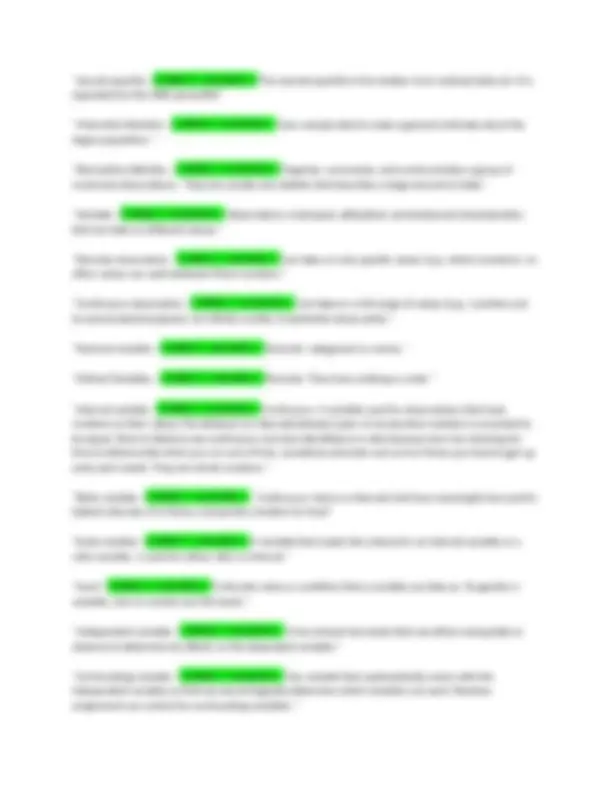
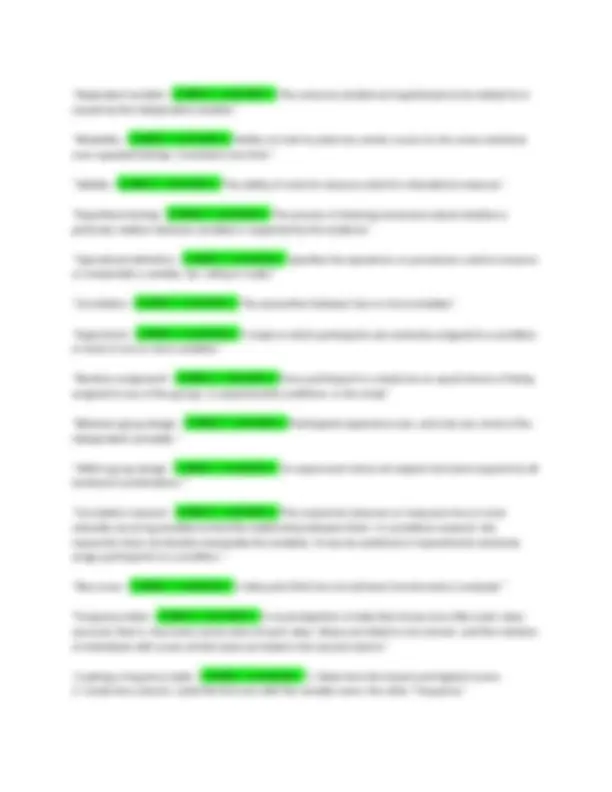
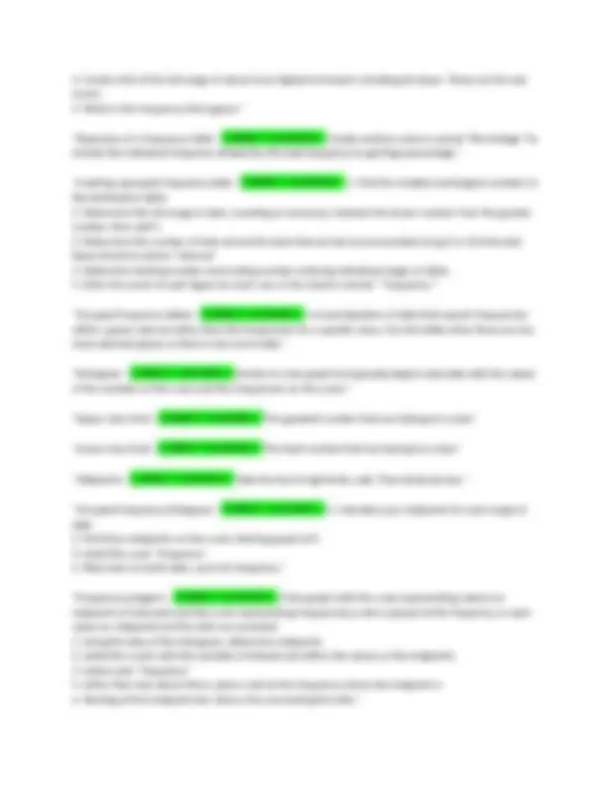
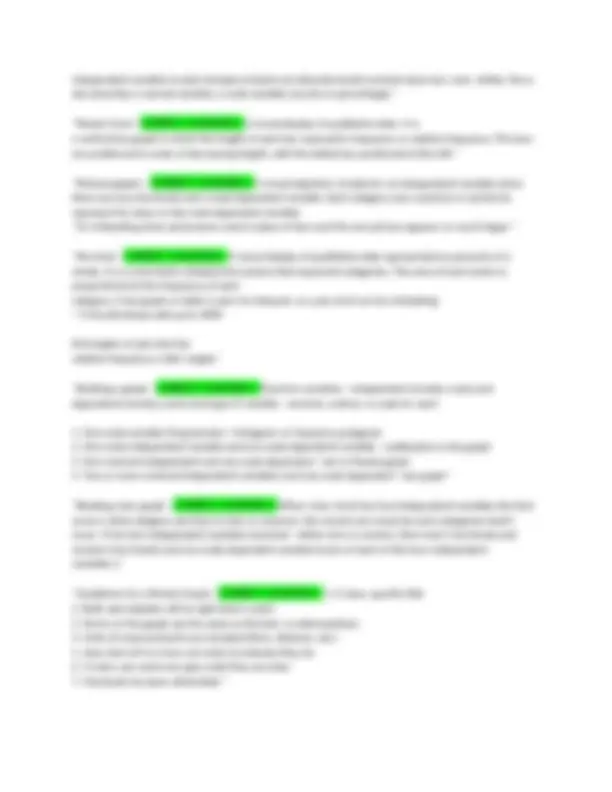
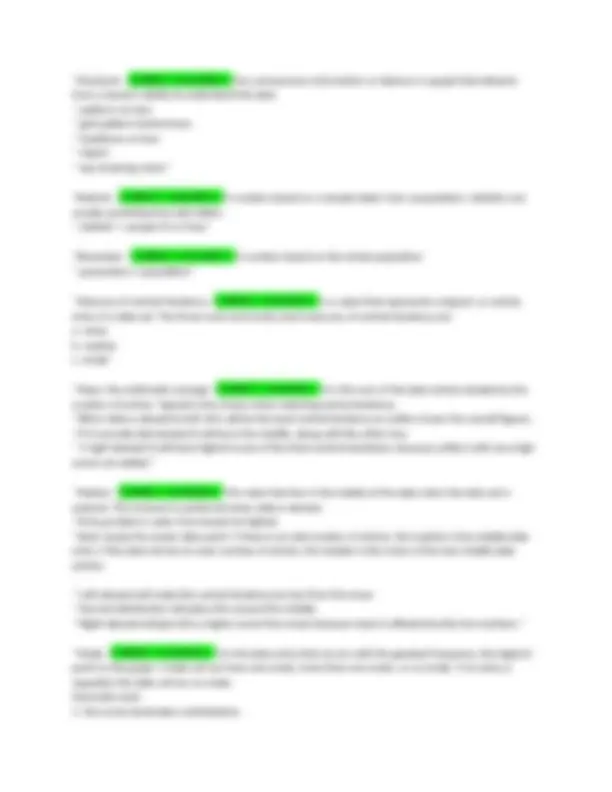
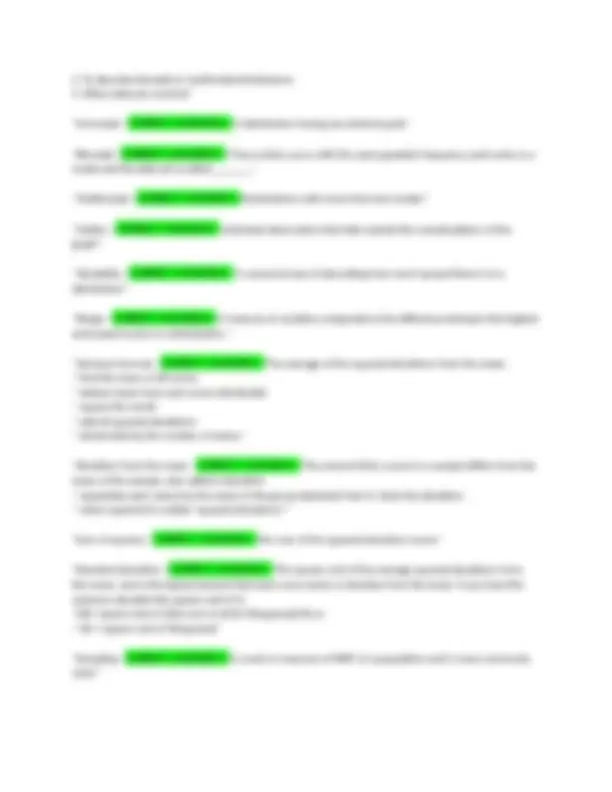


Study with the several resources on Docsity

Earn points by helping other students or get them with a premium plan


Prepare for your exams
Study with the several resources on Docsity

Earn points to download
Earn points by helping other students or get them with a premium plan
Community
Ask the community for help and clear up your study doubts
Discover the best universities in your country according to Docsity users
Free resources
Download our free guides on studying techniques, anxiety management strategies, and thesis advice from Docsity tutors
"Null hypothesis - CORRECT ANSWER=> the hypothesis that there is no significant difference between populations, or that the difference is in a direction opposite from that anticipated by the researcher." "Research hypothesis - CORRECT ANSWER=> alternate hypothesis, is a statement that postulates that there is a difference between poplulations or sometimes a difference in certain direction, positive or negative." "Type I error - CORRECT ANSWER=> Rejecting null hypothesis when it is true" "Type II error - CORRECT ANSWER=> Failing to reject a false null hypothesis" “Data - CORRECT ANSWER=> Consists of information coming from observations, counts, measurements, or responses." "Data sets - CORRECT ANSWER=> Two types used to study in statistics: -population -samples"
Typology: Quizzes
1 / 17

This page cannot be seen from the preview
Don't miss anything!










populations, or that the difference is in a direction opposite from that anticipated by the researcher."
there is a difference between poplulations or sometimes a difference in certain direction, positive or negative."
measurements, or responses."
-population -samples" "Data Set Examples: In a survey, 614 small business owners in the US were asked whether they thought their companys FB presence was valuable. 258 of the 614 said yes.
population consists of the responses of all small business owners in the US. The sample consists of the 614 responses of the small business owners in the survey. **The sample is a subset of responses of business owners in the US...the sample data set consists of 258 "yes" owners & 356 owners who said "no"" "Data Set Examples: A survey of 1015 U.S. adults found that 32% have had to put off medical care for themselves or their
from all adults in U.S. Sample: results from the 1015 U.S. adults included in the survey"
be a representative of a population. Random sampling is best. Used in Inferential."
"Sample Example:
42,000 spectators at the stadium" "Parameter Example: In January 2013, 60% of the governors of the 50 states in the USA were republicans. What is the
total number of governors" "Statistic Example: The average annual salary for 35 of a company's 1200 accountants is $68,000. What is the Statistic? -
salaries" "Descriptive Stats Example: A survey of 202 pilots found that 20% admit that they have made a serious error due to sleepiness. What
serious errors due to sleepiness" is a descriptive statistic." "Inferential Statistics Example: An inference is drawn from the sample is that "an association exists between sleepiness and pilot error."
EX: eye colors of models since eye color is a nonnumerical attribute"
EX: heights of hot air balloons"
"T or F:
statistics is a measure that describes a sample characteristic" "T or F: A population is the collection of some outcomes, responses, measurements, or counts that are of
measurements, or counts that are of interest."
"Suppose a survey of 510 women in the United States found that more than 58% are the primary investor in their household. Which part of the survey represents the descriptive branch of statistics?
of women in the sample are the primary investor in their household. inferential statistic: 58% of women the sample are the primay investor's in their houshold.." "In a recent study, volunteers who had 8 hours of sleep were three times more likely to answer questions correctly on a math test than were sleep-deprived participants. -identify the sample -the population -what part is descriptive stats?
the study. The population is the collection of the responses of all individuals who completed the math test descriptive stats: The statement "three times more likely to answer questions correctly" is an example of descriptive statistics. inferential stat: individuals who are not sleep deprived will be more likely to answer math questions correctly than individuals who are sleep deprived." "Suppose that a study based on a sample from a targeted population shows that people who own three or more televisions have more money than people who do not. -inferential stat
own three or more televisions have more money than people who own less than three televisions This inference may incorrectly imply that if you owned three or more televisions, then you would have more money than if you owned less televisions." "Using random digit dialing, researchers call 800 people and ask what obstacles keep them from exercising.
used, since each number has an equal chance of being dialed, so all samples of 800 phone numbers have an equal chance of being selected. Bias: -Individuals may refuse to participate in the sample. This may make the sample less representative of the population. -Individuals may not be available when the researchers are calling. Those individuals that are available may not be representative of the population
-Telephone sampling only includes people who have telephones. People who own telephones may be older or wealthier on average, and may not be representative of the entire population." "Questioning students as they leave a university dorm, a researcher asks 351 students about their reading habits.
sampling is used, because students are chosen due to convenience of location Bias: -Because of the personal nature of the question, students may not answer honestly. -The sample only consists of members of the population that are easy to get. These members may not be representative of the population." "Chosen at random, 420 customers at a grocery store are contacted and asked their opinions of the service they received.
sampling is used, since the business is selecting from its customers at random, and all samples of 420 customers have an equal chance of being selected. Bias: The wording of the question asked to the customers may influence them towards a particular response. The results would not be usable in this case." "Use the row of numbers shown below to generate 12 random numbers between 01 and 99.
"Why is eating eggs good for you? -Is the survey question biased?
-how do you think eating eggs effects your health?" "How much do you sleep per night during an average week? -is the question biased
to any particular answer. -no substitute needed"
center, variability (spread), and shape"
deviation has the following characteristics: -About 68% of data lie within one standard deviation of the mean -about 95% of data lie within two standard deviations of the mean -about 99.7% of data lie within three standard deviations of the mean"
deviations of the mean is at least.... 1 1- ____ K^ K=2: in any data set, at least 75% of data lie within 2 standard deviations of the mean K=3: in any data set, at least 88.9% of the data lie within 3 standard deviations of the mean"
sigma frequency"
the student is in the 78th percentile, that means that 78% of the students who took the actuarial exam fall below that score. Therefore, the student scored higher than 78% of the total number of students"
are special cases of percentiles. Upper Q is the 25th percentile, Upper Q is the 50th percentile, and Upper Q is the 75th percentile."
equivalent to the 50th percentile"
larger population."
numerical observations.. They are usually one statistic that describes a large amount of data."
that can take on different values."
other values can exist between these numbers."
to several decimal places); an infinite number of potential values exists."
numbers as their values; the distance (or interval) between pairs of consecutive numbers is assumed to be equal. (time & distance are continuous, but also identified as a ratio because zero has meaning for time & distance like when you run out of time, sometimes discrete such as # of times you have to get up early each week). They are whole numbers."
Seldom discrete, # of times a rat pushes a button for food"
ratio variable. Is used for either ratio or interval."
variable, man or women are the levels."
observe to determine its effects on the dependent variable."
independent variable so that we cannot logically determine which variable is at work. Random assignment can control for confounding variables."
include the individual frequency divided by the total frequency to get thge percentage."
the distribution table.
within a given interval rather than the frequencies for a specific value. Use this table when there are too many decimal places or there is too much data."
of the variable on the x-axis and the frequencies on the y-axis."
data
midpoints of intervals) and the y-axis representing frequenciesj a dot is placed at the frequency or each value (or midpoint) and the dots are conected.
b. Uniform distribution, even c. Skewed left distribution d. Skewed right distribution
equal or approximately equal frequencies. A uniform distribution is also symmetric."
symmetric about the mean"
is pulled away from the center" "Skewed right
*the mode is less than the median which is less than the mean"
takim on values below a point.."
"tail" of the graph elongates more to one side than to the other. The mean is lower than the median."
from taking on values above a given number."
and can lead to false assumptions."
you dig a little deeper it does not."
interpretations. (ex: used biased scales, poor, fair, good, great)."
provide data in a certain way. (only people with a strong opinion answer.)"
independent variable (x-axis) includes at least one (discrete level) nominal value (car, man, white), the y- axis describes a second variable, a scale variable (counts or percentage)."
a vertical bar graph in which the height of each bar represents frequency or relative frequency. The bars are positioned in order of decreasing height, with the tallest bar positioned at the left."
there are very few levels and a scale dependent variable. Each category uses a picture or symbol to represent its value on the scale dependent variable. *Its misleading when picturesare used in place of bars and the one picture appears so much larger."
whole. It is a circle that is divided into sectors that represent categories. The area of each sector is proportional to the frequency of each category. A bar graph or table is easir to interpret. as a pie chart can be misleading.
dependent (mostly y-axis) and type of variable - nominal, ordinal, or scale for each.
score is what category are they in (men vs women), the second one woud be each categories level's score. It has two independent variables (nominal - either men or women, then men's two levels and womens two levels) and one scale dependent variable (score of each of the four independent variables.)"
from a viewer's ability to understand the data.
usually symbolized by Latin letters
entry of a data set. The three most commonly used measures of central tendency are: a. mean b. median c. mode"
number of entries. Typicall is the choice when selecting central tendency *When data is skewed to left, this will be the least central tendency as outliers lower the overall figures. *If it normally distrubuted it will be in the middle, along with the other two.
ordered. This measure is preferred when data is skewed. *First put data in order from lowest to highest. *Next, locate the center data point. If there is an odd number of entries, the median is the middle data entry. If the data set has an even number of entries, the median is the mean of the two middle data entries.
point on the graph. A data set can have one mode, more than one mode, or no mode. If no entry is repeated, the data set has no mode. Generally used:
population. appropriate sampling techniques must be used to ensure that inferences about the population are valid and these are not made.
selected EX: using random digit dialing, researchers call 1400 ppl and ask what obstacles, such as childcare, keep them from exercising.
population EX: questioning students as they leave a university library, a researcher asks 358 students about their drinking habits ___ sampling is used bc the students are chosen due to their convenience of location
or in one context to other samples or contexts; also called external validity"
context or with a sample that has different characteristics"
which participants actively choose to participate in a study"
same size has the same chance of being selected EX: each telephone number has an equal chance of being dialed, and all samples of 1400 have an equal chance of being selected"
event will occur; also called subjective probability"
based on the actual outcome of many, many trials"
treatment; contrasts with the experimental group and serves as a comparison for evaluating the effect of the treatment."
treatment or intervention of interest in an experiment"
data in order to make decisions *Derived from the Latin word "status" meaning state involves more of counting births & deaths *Divided into 2 fields (descriptive & inferential)"